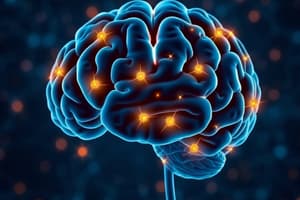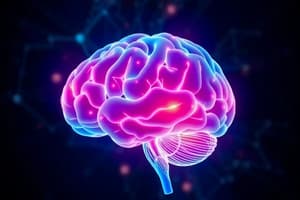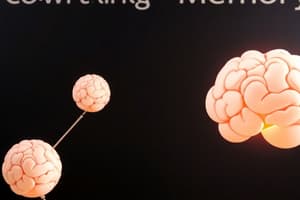Podcast
Questions and Answers
What does the dual coding effect suggest about memory enhancement?
What does the dual coding effect suggest about memory enhancement?
- Memory is enhanced when information is presented only verbally.
- Memory is improved by visual-only presentations.
- Memory is enhanced when material is coded in both verbal and spatial formats. (correct)
- Memory relies solely on auditory input for better retrieval.
Which statement best reflects the current understanding of learning styles?
Which statement best reflects the current understanding of learning styles?
- Most people can accurately assess their own learning style preferences.
- Learning styles are critical for effective teaching strategies.
- There is no conclusive evidence supporting the effectiveness of learning styles in improving learning outcomes. (correct)
- Teaching according to a preferred learning style significantly boosts performance.
What is cognitive control primarily responsible for?
What is cognitive control primarily responsible for?
- Maintaining emotional responses during tasks.
- Automatic task performance with minimal attention.
- Enhancing sensory input in memory processing.
- Updating stored information to facilitate goals and task switching. (correct)
What is the modality effect related to learning?
What is the modality effect related to learning?
Controlled processes in cognitive tasks are characterized by which of the following?
Controlled processes in cognitive tasks are characterized by which of the following?
What limitation is associated with automatic processes in memory tasks?
What limitation is associated with automatic processes in memory tasks?
The statement 'task-relevant information should be prioritized over task-irrelevant influences' primarily describes which concept?
The statement 'task-relevant information should be prioritized over task-irrelevant influences' primarily describes which concept?
The concept of 'concreteness effect' involves which aspect of memory?
The concept of 'concreteness effect' involves which aspect of memory?
What is required to mediate between competing resources in incongruent trials of the Stroop task?
What is required to mediate between competing resources in incongruent trials of the Stroop task?
Which of the following statements about habits is true?
Which of the following statements about habits is true?
In the context of cognitive control, which condition often leads to habit-driven behavior taking over?
In the context of cognitive control, which condition often leads to habit-driven behavior taking over?
How do goals influence behavior according to the content?
How do goals influence behavior according to the content?
What is a significant characteristic of automatic responses compared to controlled responses?
What is a significant characteristic of automatic responses compared to controlled responses?
What do goals primarily represent in terms of behavior?
What do goals primarily represent in terms of behavior?
Which aspect is NOT a characteristic of habits as described in the content?
Which aspect is NOT a characteristic of habits as described in the content?
What do incongruent trials in the Stroop task demonstrate about cognitive control?
What do incongruent trials in the Stroop task demonstrate about cognitive control?
What is the primary function of the central executive in Baddeley and Hitch's model of working memory?
What is the primary function of the central executive in Baddeley and Hitch's model of working memory?
Which component of Baddeley's working memory model is responsible for processing auditory information?
Which component of Baddeley's working memory model is responsible for processing auditory information?
What does the phonological similarity effect demonstrate about verbal memory?
What does the phonological similarity effect demonstrate about verbal memory?
In the context of working memory, what distinguishes maintenance from manipulation?
In the context of working memory, what distinguishes maintenance from manipulation?
What does a spatial span task measure?
What does a spatial span task measure?
How does selective interference work in relation to verbal and spatial working memory?
How does selective interference work in relation to verbal and spatial working memory?
Which of the following best describes the relationship between verbal and spatial working memory?
Which of the following best describes the relationship between verbal and spatial working memory?
Which factor can lead to natural variation in individuals' working memory abilities?
Which factor can lead to natural variation in individuals' working memory abilities?
Flashcards
Working Memory
Working Memory
A system responsible for holding and manipulating information temporarily for cognitive tasks like planning, problem solving, and memory retrieval.
Baddeley & Hitch Model
Baddeley & Hitch Model
A model of working memory with three components: phonological loop (verbal), visuospatial sketchpad (visual/spatial), and central executive (control).
Phonological Loop
Phonological Loop
The component of working memory responsible for processing and holding verbal information, including inner speech and auditory rehearsal.
Visuospatial Sketchpad
Visuospatial Sketchpad
Signup and view all the flashcards
Central Executive
Central Executive
Signup and view all the flashcards
Digit Span
Digit Span
Signup and view all the flashcards
Phonological Similarity Effect
Phonological Similarity Effect
Signup and view all the flashcards
Spatial Working Memory
Spatial Working Memory
Signup and view all the flashcards
Learning Styles Myth
Learning Styles Myth
Signup and view all the flashcards
Dual Coding Effect
Dual Coding Effect
Signup and view all the flashcards
Concreteness Effect
Concreteness Effect
Signup and view all the flashcards
Modality Effect
Modality Effect
Signup and view all the flashcards
Cognitive Control
Cognitive Control
Signup and view all the flashcards
Automatic Processes
Automatic Processes
Signup and view all the flashcards
Controlled Processes
Controlled Processes
Signup and view all the flashcards
Cognitive Control Adaptation
Cognitive Control Adaptation
Signup and view all the flashcards
Stroop Task
Stroop Task
Signup and view all the flashcards
Incongruent Trial
Incongruent Trial
Signup and view all the flashcards
Congruent Trial
Congruent Trial
Signup and view all the flashcards
Habit
Habit
Signup and view all the flashcards
Goal
Goal
Signup and view all the flashcards
Cognitive Control and Habits
Cognitive Control and Habits
Signup and view all the flashcards
Changing Undesirable Habits
Changing Undesirable Habits
Signup and view all the flashcards
Study Notes
Working Memory and Cognitive Control
- Working memory is a set of processes for storing and manipulating information in short-term memory. It's involved in controlling attention, planning, and problem-solving, and directing encoding and retrieval from long-term memory.
Baddeley and Hitch Model
- This model proposes three components of working memory:
- Phonological loop: processes verbal information using auditory representations (e.g., inner voice). Includes mental rehearsal.
- Visuospatial sketchpad: processes visual and spatial information (mental images).
- Central executive: controls and monitors the other components, transfers information to and from long-term memory, and handles manipulation.
Verbal Working Memory
- Digit span: Measures the longest sequence of items a person can recall in order.
- Phonological similarity effect: errors increase when recalling similar-sounding information.
- Evidence shows verbal information (even visual input like reading) is encoded acoustically.
Spatial Working Memory
- Spatial span tasks assess the ability to remember sequences of locations.
- Verbal and spatial working memory are independent, with different activities relying more on one or the other.
Cognitive Control
- The ability to manipulate working memory, update information, plan, switch tasks, select stimuli, and inhibit responses. Needed for flexibility in activities.
- Automatic processes: require less attention, performed with practice (e.g., habitual behaviors).
- Controlled processes: require attention, slower to execute (e.g., complex tasks).
Natural Variation in Working Memory
- Some individuals might have strong spatial but weak verbal working memory.
The Myth of Learning Styles
- There's no scientific evidence that learning styles (visual, auditory, kinesthetic, etc.) consistently impact learning performance.
Dual Coding Effect
- Memory is enhanced when material is coded both verbally and spatially.
Modality Effect
- Learning is improved when materials use multiple modalities (e.g., visual and auditory).
Stroop Task
- Measures cognitive control: naming the color of ink versus the word printed, incongruent stimuli require more cognitive control to overcome automatic responses.
Cognitive Control and Habits
- Behavior is a balance between controlled and automatic responses.
- Habits are formed through repetition, faster than controlled responses.
Cognitive Control and Goals
- Goals are often less effective at directing behavior if they conflict with well-established habits.
- Cognitive control is necessary to override habitual responses to meet goals.
Studying That Suits You
Use AI to generate personalized quizzes and flashcards to suit your learning preferences.




